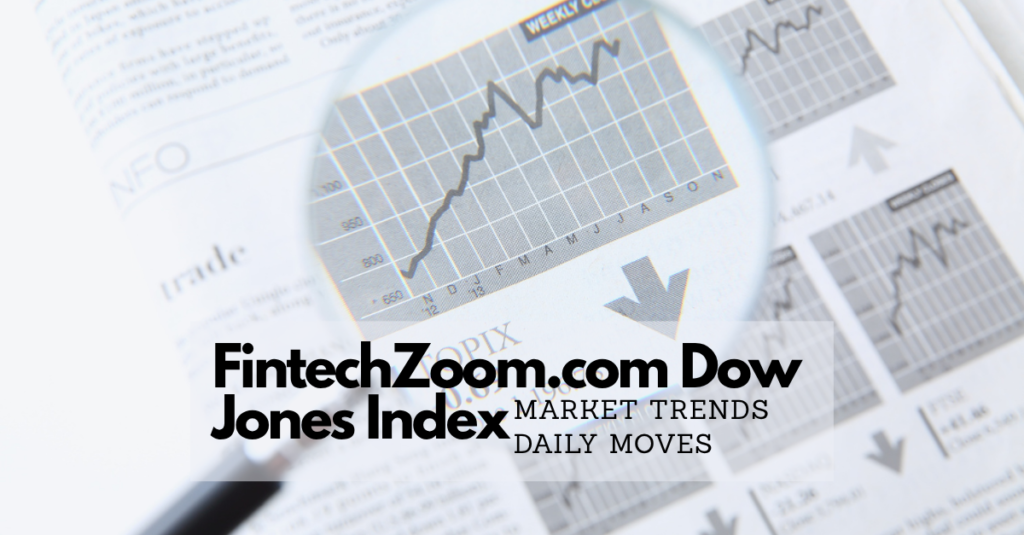The stock market changes daily, and for someone new to investing, it can feel confusing. You often hear news like “the Dow Jones went up today” or “the Dow Jones fell after inflation data,” but what does that really mean? The Dow Jones is one of the most closely watched indexes in the world, providing a snapshot of how the U.S. economy and its leading companies are performing. Understanding it helps us see not only the health of American business but also how global events affect financial markets. A question many beginners have is where to find clear and simple explanations about the Dow and its daily moves. This is where FintechZoom.com becomes valuable. FintechZoom is a website that provides news and updates about financial markets, including major indexes like the Dow in real time, breaking down complex updates into easy explanations so that both beginners and experienced investors can stay informed.
- What is the Dow Jones Index?
- How the Dow Jones is Calculated
- What Moves the Dow Daily
- Big Companies That Shape the Dow
- Comparing the Dow Jones with Other Indexes
- Economic Data That Impacts the Dow
- How to Invest in the Dow
- How the Dow Changes Over Time
- The Dow as a Picture of the U.S. Economy
- How FintechZoom Helps You Follow the Dow
- Conclusion
- FAQs
What is the Dow Jones Index?

Behind all the daily ups and downs in the stock market, there are certain indexes that help us understand what is happening in the market. One of the most famous of these indexes is the Dow Jones Industrial Average (DJIA), often just called the Dow Jones or the Dow. The Dow Jones has been around for more than 100 years and is closely monitored by traders and financial professionals worldwide.
The Dow Jones tracks thirty major companies in the United States. These are not small or unknown businesses—It tracks some of the most influential companies in the market, including Apple, Microsoft, Goldman Sachs, Boeing, Johnson & Johnson, and Coca-Cola. Because the index focuses on these big, important companies, its movements give us a clear idea of how the American economy is performing.
If the Dow is rising, it usually shows that investors believe these companies will do well and that the economy is strong. If the Dow is falling, it reflects worries about profits, jobs, or future economic growth. For this reason, media outlets globally cover the Dow’s daily changes, and investors rely on it to understand the strength of the U.S. economy and its leading companies.
How the Dow Jones is Calculated

The Dow is not just an average of stock prices. It uses a special method called a price-weighted calculation. This means that shares with higher prices carry more weight and impact the index’s movements more strongly.
For example:
If a company with a stock price of $400 moves up by $5, it will impact the Dow more than a company priced at $50 moving up by the same $5.
This system sometimes makes the Dow a little different from other indexes like the S&P 500, which is weighted by market value instead of price. FintechZoom.com often explains these calculations in easiest way so that even beginners can understand how changes in just a few stocks can move the whole index.
What Moves the Dow Daily

The Dow Jones moves every day because of several main factors. These are the things that cause the index to go up or down:
Company Earnings: When a company in the Dow reports strong profits, its stock usually rises, which can pull the Dow up. If profits are lower than expected, the stock may fall, which can push the Dow down.
Economic Data: Reports about jobs, inflation, interest rates, and overall economic growth can influence the Dow. Positive reports often boost the index, while negative reports can lower it.
Global Events: News about trade, oil prices, political tensions, or natural disasters can affect market confidence and change the Dow’s performance.
Investor Sentiment: The mood of investors matters. Optimism can drive stocks higher, while fear or uncertainty can cause declines.
Platforms like FintechZoom.com provide daily explanations of these movements. They help beginners see why the Dow changed on a particular day and connect market numbers to real-world events.
Big Companies That Shape the Dow

Not all 30 companies in the Dow have the same impact on the index. Some stocks have a bigger effect because of their higher prices and larger presence in the market. These companies are often called top movers because changes in their stock prices can significantly influence the Dow’s daily performance.
Some of the most influential companies in the Dow include:
Apple and Microsoft – These technology giants have high stock prices and large market influence, so their movements can affect the Dow more than smaller companies.
Goldman Sachs and JPMorgan Chase – Big banks that respond strongly to interest rates and economic news, which can impact the index.
Boeing – An industrial giant; major news about airplane orders or production can swing the Dow.
Johnson & Johnson and UnitedHealth Group – Healthcare companies that often stabilize or move the index depending on news about earnings or healthcare policies.
FintechZoom.com provides updates highlighting which companies are leading the Dow up or down each day. For beginners, this makes it easier to see the connection between a large index number and the performance of specific, familiar companies.
Comparing the Dow Jones with Other Indexes

The Dow Jones is one of several major stock market indexes in the United States, but it is not the only one. Two other well-known indexes are the S&P 500 and the Nasdaq. Understanding the differences between them helps beginners see why the Dow is unique and how it fits into the bigger market picture.
S&P 500 – This index tracks 500 large U.S. companies, giving a broader view of the overall market. It is weighted by company size, meaning larger companies have more influence regardless of share price. The S&P 500 often shows trends across a wider range of industries than the Dow.
Nasdaq – This index includes mostly technology and growth-oriented companies. It is also market-cap weighted and tends to be more volatile because tech stocks can move quickly.
Sometimes the Dow, S&P 500, and Nasdaq move in the same direction, but other times they behave differently. For example, if tech companies perform well but industrial stocks lag, the Nasdaq may rise while the Dow falls. Platforms like FintechZoom.com show side-by-side comparisons of these indexes, helping beginners understand how different parts of the market react to the same news or economic events.
Here is a simple comparison table:
| Feature | Dow Jones Industrial Average | S&P 500 | Nasdaq |
| Number of Companies | 30 | 500 | Over 3,000 |
| Weighting Method | Price-weighted | Market-cap weighted | Market-cap weighted |
| Focus | Large, established companies | Large and mid-sized companies | Mostly technology and growth stocks |
| Volatility | Moderate | Moderate | High |
| Representation | U.S. economy’s blue-chip sector | Broader U.S. economy | Tech-heavy market trends |
For beginners, this is important because it teaches that no single index can explain the full picture, but together they help us understand what is happening in the economy.
Economic Data That Impacts the Dow

The Dow Jones does not move only because of company news. Broader economic factors also play a big role in influencing the index. These factors are called economic indicators, and they help investors understand the overall health of the economy.
Some of the most important economic indicators include:
Jobs and Unemployment Reports – When unemployment is low, people have money to spend, which helps companies grow and can push the Dow higher. If unemployment rises, the Dow may drop because of concerns about slower consumer spending.
Inflation – Inflation measures how fast prices for goods and services are rising. High inflation can worry investors because it may lead to higher interest rates, which can slow economic growth and lower stock prices.
Interest Rates – The Federal Reserve sets interest rates. When rates go up, borrowing becomes more expensive for companies and consumers, which can negatively affect the Dow. Lower rates can encourage spending and investing, which can push the index higher.
Gross Domestic Product (GDP) – GDP shows the total value of goods and services produced in a country. Strong GDP growth usually supports a rising Dow, while weak growth can make investors cautious.
Consumer Confidence – This measures how optimistic or pessimistic consumers feel about the economy. High confidence often leads to more spending and a rising Dow, while low confidence can slow growth and push the index down.
Platforms like FintechZoom.com help beginners understand these indicators by explaining how each report or data release may affect the Dow. Instead of just seeing numbers move, readers can see the reason behind market trends, which makes following the stock market much easier.
How to Invest in the Dow

Following the Dow Jones is one thing, but many people want to invest in it to grow their money. Buying all thirty individual companies in the Dow would be complicated and expensive, so there are simpler ways to invest in the index.
Exchange-Traded Funds (ETFs): ETFs like DIA track the Dow’s performance. By buying shares of an ETF, you invest in all 30 companies at once, without buying each stock individually.
Index Funds: These are mutual funds that also follow the Dow. They are a good choice for long-term investors because they are low-cost and diversified.
Futures and Options: These are tools for experienced investors who want to trade short-term movements of the Dow. They can make profits quickly but also carry higher risks.
Investing in the Dow allows beginners to participate in the U.S. stock market with less risk than picking individual stocks. Platforms like FintechZoom.com provide guides and explanations on how ETFs and index funds work. They also help beginners understand the risks and benefits of different investment options, making it easier to choose the right strategy.
People Also Read: Stock Market Insights 2025: Tesla, Apple, Futures, and More on FintechZoom
How the Dow Changes Over Time

The Dow Jones Industrial Average is not fixed forever. Its list of thirty companies changes over time to reflect the shifts in the U.S. economy. When the index was first created more than 100 years ago, it mostly included industrial and manufacturing companies. Over the decades, new sectors like technology, healthcare, and finance became more important, and the Dow changed to include companies from these growing industries.
For example, General Electric (GE) was part of the Dow for many decades but was eventually removed when it no longer represented the modern U.S. economy. At the same time, technology companies like Apple, Microsoft, and Salesforce were added to reflect the rise of the tech sector. These updates ensure that the Dow continues to provide a relevant picture of the U.S. economy, showing the strongest and most influential companies rather than just old industrial businesses.
Platforms like FintechZoom.com report on these updates and explain why companies are added or removed, helping beginners understand that the Dow is a dynamic index that evolves as the economy changes.
The Dow as a Picture of the U.S. Economy

The Dow Jones is more than just a number on the stock market ticker. It acts as a snapshot of the U.S. economy, reflecting how large companies are performing and how investors feel about the future. When the Dow rises, it usually indicates that businesses are making profits, investors are confident, and the economy is generally healthy. When the Dow falls, it can signal concerns about economic growth, jobs, or other challenges in the market.
Because the Dow tracks thirty major companies from different sectors, it gives a broad view of the economy’s strength. While it does not cover every company in the U.S., it highlights the performance of key industries like technology, finance, healthcare, and industrials. By watching the Dow, investors, policymakers, and even everyday people can get a sense of the overall economic climate without analyzing every individual company.
Platforms like FintechZoom.com help beginners understand this relationship by explaining how movements in the Dow connect to real economic events. For example, a rise in the Dow after strong job data or a drop following higher inflation is easier to interpret when it is clearly explained. This makes the Dow a useful tool not just for investors, but for anyone who wants to understand the health of the U.S. economy in a simple way.
How FintechZoom Helps You Follow the Dow

Understanding the Dow Jones can be confusing for beginners, but platforms like FintechZoom.com make it much easier. FintechZoom provides real-time updates, daily summaries, and expert explanations that help readers understand why the Dow moves up or down each day.
For example, instead of just seeing a headline like “the Dow fell 300 points,” FintechZoom explains the reasons behind the movement, such as weak earnings from a major company, changes in interest rates, or global events affecting markets. It also highlights which specific companies in the Dow are driving the changes.
FintechZoom shows this information in several ways:
Live Charts and Graphs: Interactive visuals let readers see how the Dow moves throughout the day.
Tables of Top Gainers and Losers: Readers can quickly see which companies had the biggest impact on the index.
Daily Summaries: Short, simple articles explain the day’s key market movements in plain language.
News Updates: Relevant economic and global news is linked directly to how it affects the Dow, making connections easy to understand.
Comparison Tools: Users can compare the Dow with other indexes like the S&P 500 and Nasdaq to see broader market trends.
In addition, FintechZoom provides guides on how to invest in the Dow using ETFs or index funds, making it practical for readers who want to start investing. By using these tools, beginners can follow the stock market with confidence, understand daily trends, and connect economic events with the Dow’s performance. It serves as a bridge between complex financial data and easy-to-understand explanations, making the Dow accessible to everyone.
Conclusion
The Dow Jones Industrial Average is one of the most important indexes in the world. It tracks thirty large companies and reflects the health of the American economy. Its daily moves are shaped by company earnings, economic data, investor mood, and global events. For someone new to investing, the Dow is a simple starting point to learn how markets work. But following it alone can be difficult because the numbers do not always tell the full story. That is why FintechZoom.com is such a valuable resource. It provides easy explanations, real-time updates, and expert analysis that help readers understand not just what the Dow is doing but also why it is moving. By using FintechZoom as a guide, beginners can learn to read the stock market with more confidence. The Dow Jones tells the story of American business and economic strength, and FintechZoom helps everyone read that story in clear, simple language.
FAQs
Q: How can I see real-time Dow movements on FintechZoom?
A: FintechZoom provides live charts and graphs that update during market hours. You can track the Dow’s daily performance and see which companies are moving the index.
Q: What are the top gainers and losers in the Dow?
A: FintechZoom highlights the companies that have the largest increases or decreases each day. This helps beginners understand which businesses are driving the market.
Q: Can I use FintechZoom to compare the Dow with other indexes?
A: Yes, FintechZoom offers comparison tools so you can see the Dow alongside the S&P 500 and Nasdaq to understand broader market trends.
Q: Does FintechZoom explain why the Dow moves on certain days?
A: Yes, every day, FintechZoom provides simple explanations connecting market movements to earnings reports, economic data, or global events.
Q: How can I track Dow performance for investing purposes?
A: You can follow FintechZoom’s daily summaries, charts, and tables to learn patterns over time. This helps beginners make informed decisions when investing in ETFs or index funds.
Q: Can I learn how to invest in the Dow using FintechZoom?
A: Yes, FintechZoom provides guides on ETFs, index funds, and investment strategies, making it easier for beginners to start investing in the Dow.
Q: Are there any tools for beginners to practice or track the Dow?
A: FintechZoom offers interactive charts and historical data, which allow beginners to study past movements, see trends, and understand market behavior.




